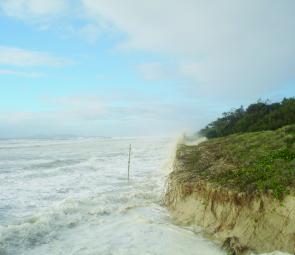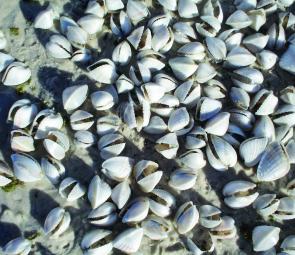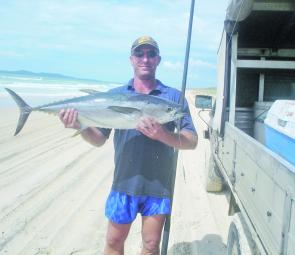Weather permitting; February always has the potential to bring on extraordinary beach fishing along Teewah and Rainbow Beach. The pelagic species that migrate past during summer and early autumn are all present, as are all of the bread and butter species that can inhabit these water. Usually all that is required is the opportunity to get at them.
Low pressure systems, south easterlies, and cyclones, can all be a menace during in February. Last year, the lows seemed to line up one after the other to keep the seas pounding and the wind didn't seem to drop below 30knots through the first four months of the year. Hopefully this year winds will not be so persistent. Keen beach anglers should keep an eye on current conditions for the sometimes small windows of opportunity that can occur with short notice.
Weather trends seem to have reverted back to the days of old. Some of the storms that we've experienced lately are packing a bit more punch than I recall and the sun seems hotter than it was when I was twenty, but there does appear to be a fairly predictable trend developing.
Southeasterly winds were always a February constant during the 70’s and 80’s and a new high pressure system would generally make an appearance in the Great Australian Bight every week or so. Indications show this will be the trend for the coming month or two at least, so planning fishing trips to coincide with the best available weather is definitely possible.
Strong southeasterly winds create swell on the open beaches and also a sweep towards the north that can make fishing impossible. So the time to hit the beach is the day or two after the breeze has swung around to the northeast and as the swell is dropping off before the next southeaster hits. But any low pressure systems within 1000-2000km can exacerbate swell and prohibit fishing through the northeasterly wind change. It can be disappointing to have the winds doing the right thing, but discover on arrival that the swell is huge and unfishable. Good for the surfers, but a misery trying to fish or eve just drive along the beach.
Of course many anglers will know that perfect conditions aren't necessarily when fish are to be caught. Some of the best tailor fishing that I have done is when the Noosa River is in full flood and the winds howling out of the southeast. The tailor are there to feed on the gar, poddy mullet, prawns or anything else of a suitable size that flushes out with the fresh. Bream also take advantage of this situation and can be found in the dirty water at the mouth. Big eye and giant trevally are often present as well.
Metal lures or baits both work on the tailor in the dirty water and I've found that the dirtier the water the better. However, I find quickly retrieved surface lures to be far more productive and don't suffer the problems associated with flood debris that baits do. Often the tailor at this time of year are large greenbacks in schools that are hungry and can stay on the bite for the entire run of the tide and even all day or night. The trevally will also take the metal lures and the bream will hungrily take mullet gut or flesh, pipi or worm.
Usually, when the flood first starts, the tailor will bite on the run-in tide. As the fresh slows down and the incoming tide brings cleaner sea water around Noosa Heads, the outgoing tide of dirty fresh water is when the fish will chew. Dragging lures off the sand bars that form on either side of the mouth into deeper water with white water covering it is most productive.
The Noosa River also has the advantage of being at the very southern end of Laguna Bay, which is sheltered a little from the southeasterlies by Noosa Heads. The beach at this point is facing towards the northeast and doesn't have the southeasterly wind as a directly onshore breeze. Any stream in South East Queensland that is in flood during summer and early autumn can work for tailor and other species in exactly the same fashion as the Noosa.
Australian anchovy are also attracted to the dirty water emptying into Laguna Bay in their attempts to hide from the schools of mackerel and tuna. As the water clears, the anchovy become concentrated close to the remaining fresh at the river mouth and north shoreline, which is when the mackerel and tuna along with tailor, dart and trevally, all play a role in herding the bait towards the beach. This is the time beach anglers can get amongst fish that are normally the domain of the boatie. Metal lures of generally no less than 30g are by far the best way to tap in to these fish and schools can come within casting range anywhere and at any time.
The open beach also fishes particularly well following weather events. The water may still be dirty from the fresh and swell, but the fish are hungry following a period that has been difficult for them to feed. Bream in particular are available in these conditions and definitely seem to prefer mullet gut or flesh whilst the water is dirty. As the water clears, their preference is for eugarie or beach worm.
The northern side of Double Island Point is another location that can be fished when the southeasterlies are in full swing. Flathead, whiting, dart and bream can be taken on the usual baits of worm and eugarie, but plastics are definitely worth trying for the flathead. Longtail and mac tuna can sometimes be found within casting distance from the shore here along with school, spotted and broad barred mackerel, queenfish and tailor all feeding on baitfish that have been herded to shore. Metal lures are the most proven way to target these pelagics.
The Christmas holiday period along Teewah Beach was once again extremely busy and hot sticky conditions made the beach the place to be. Lovely calm conditions allowed everyone to enjoy the cooling surf in safety and the northeasterly sea breeze each afternoon made for extremely pleasant conditions. Unfortunately, these conditions are also ideal for algal growth and the anaulus australis took full advantage.
Most people won't have noticed that the water was a distinct green colour like a swimming pool lacking the usual maintenance. The water is still relatively clear and there is no weed to announce its presence, but the algae deoxygenates the water and fish simply don't like it. As a result, captures from the surf of any quantity or quality were a little limited with dart, whiting and tarwhine the main species caught. A few good quality tailor were taken, but reports of these fish have been few and far between.
At Fraser Island, this same algae has been present on the eastern beach for months now and I discovered just before Christmas that the western beach of Fraser is in an even worse state with a different algae. What I believe to be lyngbia is rendering the beach unfishable with weed in massive quantities along the entire west coast.
Of great concern were the thousands of shellfish (white half cockle) that were being deposited along the beach and which were soon dead. The same algae is killing mangroves in Wathumba Creek which highlights its toxic nature. This is not a new scenario and I've seen it several times over the last 10 years with similarly destructive results
I'm aware that research into the nutrients that are causing algal blooms is currently being conducted with the jury still out on the origin of these nutrients. However to me there seems to be little doubt given the number and variety of algal blooms in the Fraser region, that the origin would be the streams flushing into Hervey Bay. Cane farming is the main agriculture in this district and algal blooms in the Mary River common place. So, in my opinion there is a fairly obvious connection between the two that must be addressed promptly before tragic environmental consequences result.
As a tourist destination, Fraser Island is world famous and the post card images of blue water against white sandy beaches that draw these tourists make it understandably so. However, the reality for tourists on arrival there these days, is stinking brown surf that I wouldn't swim in, and I doubt many others would either. Of course there are the lakes such as Mackenzie that do still have clear water and white sandy beaches, but recent media reports of these lakes being less than healthy must be of concern to tourism chiefs and operators.
It has recently been reported in the media that the introduction of beach permits for vehicles has been delayed due to the large number of public submissions to be worked through. This may be the case, or perhaps an imminent State election could be a factor here. Irrespective, Teewah Beach is still free to drive on and it could be months before the permits come into being.
Reads: 1909
In summer when there is a low pressure system around the beaches get a thrashing.

The algae on the west side of Fraser Island caused thousands of cockles to wash up onto the beach where they soon died.

This Teewah Beach longtail tuna was caught on a Slider. Mac and longtail tuna can sometimes be found within casting range of the beach in February.




